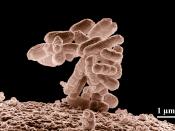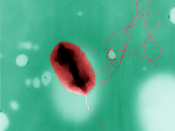- -
Biology
Escherichia coli
Escherichia coli
Escherichia coli is an Enterobactericeae bacteria. This family name is derived from the fact that nearly all species in it, more or less, constantly inhabit the intestines of humans and animals. Because of its widespread presence in the environment and its ability to promote disease in humans, one of the most prominent members of this family is the species Escherichia coli. This bacterium is so common that its name has come to describe all similar bacteria as "coliform" or coli-like.
These enterobacteria are gram-negative, nonspore-forming straight rods, aerobic and facultative anaerobes, ranging from 1 to 2 mm in diameter and are from 3 to 10 mm in length. All species ferment glucose, which allows for a testing method known as "presumptive E. coli," and all microscopically, are indistinguishable. Most species are motile with nonpolar flagellae. They have been classified by a system developed in part by Edwards and Ewing, and Escherichia was named after a German scientist named Escherich.
Enterobactericeae is subdivided into five tribes, Escherichieae being one of them.
E. coli occurs in enormous numbers in normal feces and is widely distributed in the intestinal canal of animals and humans. Ordinarily, it does no harm. Various species of E. coli are of special importance to medical and sanitation personnel because certain serotypes cause intestinal and urinary tract infections and are transmitted in water and milk. E. coli is very similar to Salmonella and Shigella bacteria and can only be distinguished during biochemical tests in a laboratory.
E. coli is present in health people and animals, and actually aids in the digestive processes. The majority of E. coli in the intestinal tract are not disease-causing to the host organism, but if by chance the bacteria enter the urinary tract or any other...


